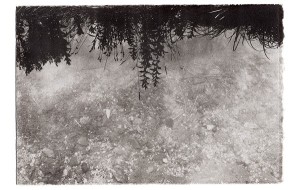
John Ryan Brubaker, Untitled, 2015
From May 28 – June 12, 2016, the White Room Art Gallery will present On Confluence: Walks Down the North Fork, a series of new works by Thomas, West Virginia and Brussels, Belgium-based photographer John Ryan Brubaker. For this series, the artist, who currently serves as an Artist Research Fellow at the Belgian university LUCA School of Arts, has created a new method to develop photographs based on the Van Dyke Brown print process invented around the turn of the 20th Century.
In creating these photographs, the artist has employed the subject matter – the North Fork River in Thomas, West Virginia – for use as the developing agent of the images. The river, which flows through a town born out of the coal industry around the same time the Van Dyke process was created, has long been considered off-limits by locals and tourists due to pollution caused by acid mine drainage from abandoned coal mines.
The mine system surrounding the river covers 1100 acres and discharges an average of two million gallons of water each day into the North Fork. This water has a pH in the 3.0 – 5.0 range with heavy concentrations of iron and aluminum. Brubaker discovered that the chemical composition of the water flowing in the North Fork mirrors the conditions needed for the Van Dyke process. Following months of trial and error, the artist was able to form a methodology to develop his prints using the river water itself. The images are exposed on the riverbanks using sunlight.
The resulting photographs compel the viewer to find a new sense of awe in something that has been long-tarnished by a mandate to charge forward in the name of progress. The symbolism unraveled in these one-of-a-kind artworks begs at the parallel arc found in the history of the photographic art form itself – one of discovery, development and, following, an aggressively-charged leap forward due to advances touted by technology companies.
The artist’s body of work prompts the question, how can we flip a narrative now rooted in selfie-sticks and like-ephemera to bring about new perspective on a century-old creative practice?
The North Fork waters flow in colors ranging from dull browns to bright oranges, and Brubaker’s Van Dyke process yields a palette rich in tonal variety that echoes what a visitor would find on site at the river. Brubaker’s photographs capture some scenic elements, but largely feature abstract and detail imagery of the river and surrounding environment. The artist intentionally obscures his subject matter to force the viewer to spend more time considering each image, seeking out what the photograph portrays.
“The high caliber of the creative series that John Ryan has assembled is an example of the type of project that merits national attention for West Virginia. It is our cultural exports that shine a light on the positives our great state has to offer. These photographs recently showed at Carnegie Hall in Lewisburg and now will be on view in the town where they were captured, Thomas. We are currently supporting John Ryan in his efforts to secure venues to show the work outside of the state. We are proud to collaborate with this talented artist as part of our Rural to Urban Markets program,” says Tamarack Foundation for the Arts Executive Director Alissa Novoselick.
Brubaker, who splits his time between a major metropolitan area in Europe and a remote town of 600 residents in the United States, was seeking a way to translate his urban path-finding photography practice to a rural setting. He saw the Appalachian waterways as the ideal parallel.
“My work is often based on explorations of unknown spaces, and the aimless wander or intentional walk has become an important part of my practice. The experience of engaging with the immediate physical environment has become an essential element in my most recent projects. I make these works because I am interested in the visual environment of contemporary human civilization – I am interested in the infrastructure in which we live rather than in a particular scene or event. I believe that immediate visual surroundings deeply effect personal emotional and psychological well-being, and I use visual art to both explore and explain this perspective,” says Brubaker.
To capture the images in On Confluence, the artist was forced to walk through the riverbed itself. The rural nature of the subject matter meant that the riverbanks were largely inaccessible.
“My recent projects have all involved personal integration with space, On Confluence perhaps being the most extreme. I undertook an extensive research process with local water quality experts to find out if walking in the river was safe. I received advice from both water reclamation experts and local outdoors enthusiasts as to how I could engage the river without long term physical effects from absorbing the heavy metals in the water. Ultimately, these walks became an essential performative aspect of the project,” says the artist.
While the state of the river is an integral part of On Confluence, the artist is not seeking traditional activism as an end goal for the series, but rather hopes the project will prompt a discussion around opportunities for photography to grow and diverge from today’s common practices; the meeting of art and science as a field of study; and a greater awareness of the possibilities to be found in our surrounding environment.



